Barcelona, Sunday-Wednesday, June 17-20, 2007
Arrival
After a long day of driving we arrived in downtown Barcelona and checked our sources for a campsite. As we arrived, the “Autovia” ended and we remarked that the area we drove through looked a lot like Queens, NY. We followed the usual signs to the center of the city. Most of the avenues of the late nineteenth century portion of the city are broad. The corners of the buildings that face into the intersections have been “cut off” which makes for even larger open spaces every hundred meters or so.
We found a place to park, put money in the meter (even though it was late Sunday afternoon) and walked into the main square… looking for WiFi. We had not had an opportunity to check our mail since Thursday in Toulouse. We saw a Starbucks. The fellows we saw there with their laptops open told us how to find another Starbucks nearby that supposedly did have WiFi. We walked the few blocks past exquisitely flowering trees (that… while looking at the photo now suggests a Klimt painting),

encountered a demonstration (Mark is not the only person who takes photos of political literature):
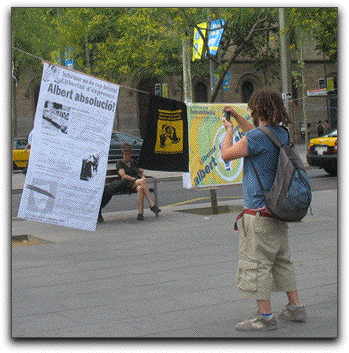
and saw the riot police out in full force. Nothing happened.
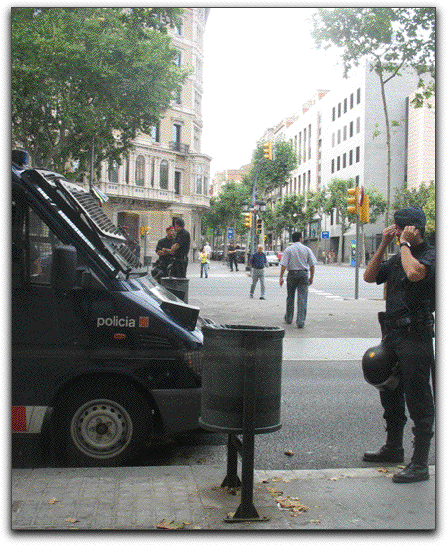
At the Starbucks, across the street from the demonstration, nothing happened there either. We couldn’t even connect… even though the WiFi existed. So, the proprietor gave us a coupon for a free drink!
Our campsite “Camping Tres Estrellas” was about 15 kilometers outside the city, beyond the airport, just west of the outbound flight path (at least the first night) near some kind of creek that stank of rotten eggs. However, the neighbors were nice and the view from the open door of our van could not have been better.
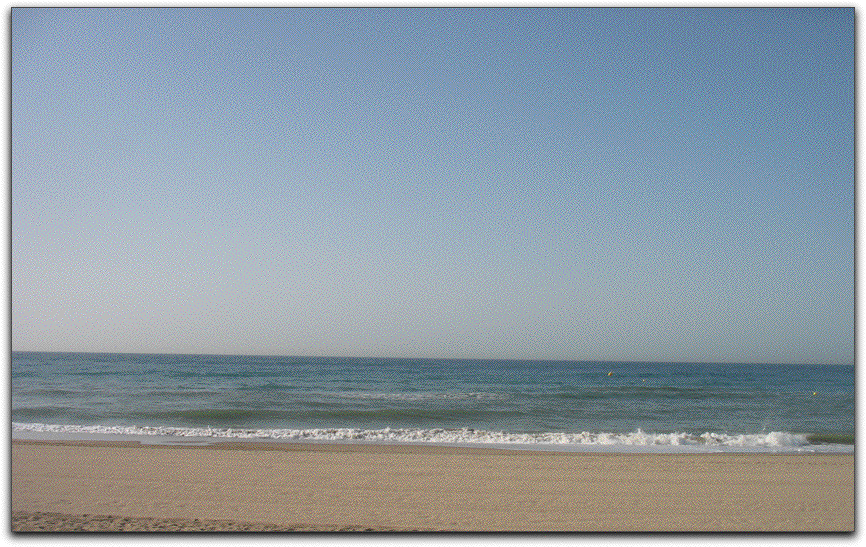
The trip into town
The express bus took about an hour. Groups of “campers” trekked out from the campsite the 500 meters to the bus stop, working up a sweat even before the day started. Red poppies shared the side of the side of the road with clusters of pine and ladies of the highway.
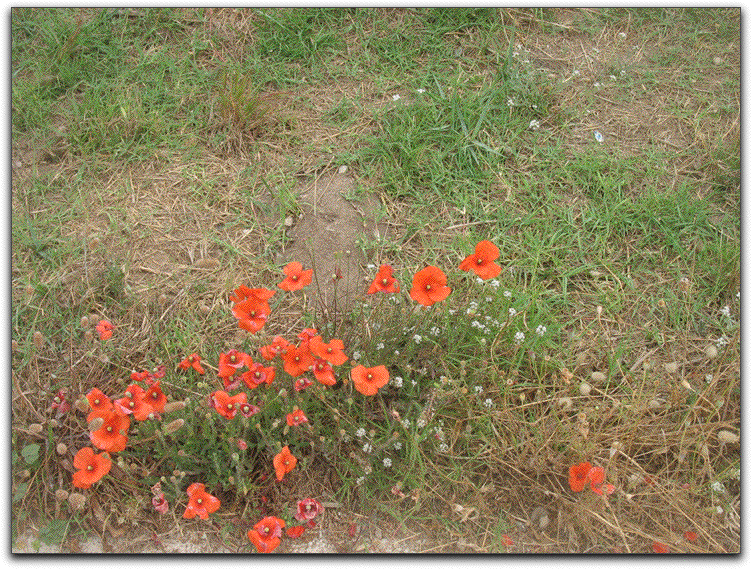
Mark always tries to say “hello.” So, when we saw a young family on the bus who we had seen at camp, Mark started talking with them. It turns out they are from Italy, a mother and father traveling with their (approximately) 10 year old son and 8 year old daughter. The mother’s English is quite good and with Mark’s fractured Spanish-inflected Italian we were able to compare notes of what we were planning for the day. We encountered this same family in Granada and again in Cordoba, even though some of our in-between excursions differed.
First on the Agenda
Barcelona has the first chocolate museum we’ve found that does not, as part of its mission, try to sell one particular brand of chocolate. Nonetheless, every museum has its own chocolate story to tell. In this regard the museu de la xocolata

is no different.

We had a long list of chocolate establishments to discover and explore so,
after tasting a cup of hot chocolate (made with Valhrona French chocolate) at the museum

we set off.
Our first stop was in the port, in the new mall by the aquarium and the marina where we took our portrait for that day. Mark enjoyed seeing Christoper Columbus (Christobal Colon) towering among the masts of all the local boats. Columbus’ trip to the western hemisphere, after all, ultimately introduced chocolate to Europe.
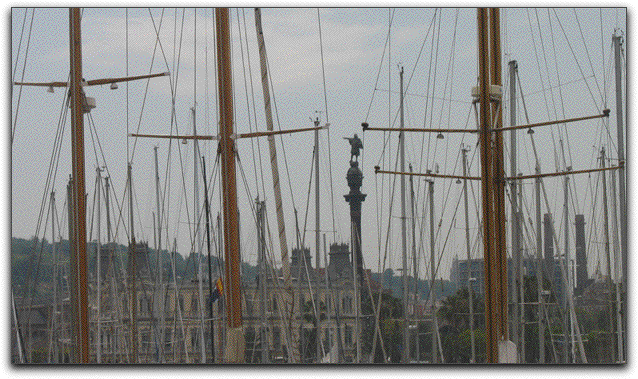
Along the way we saw more flowering trees. These may have been the ones we saw in Gernoa.
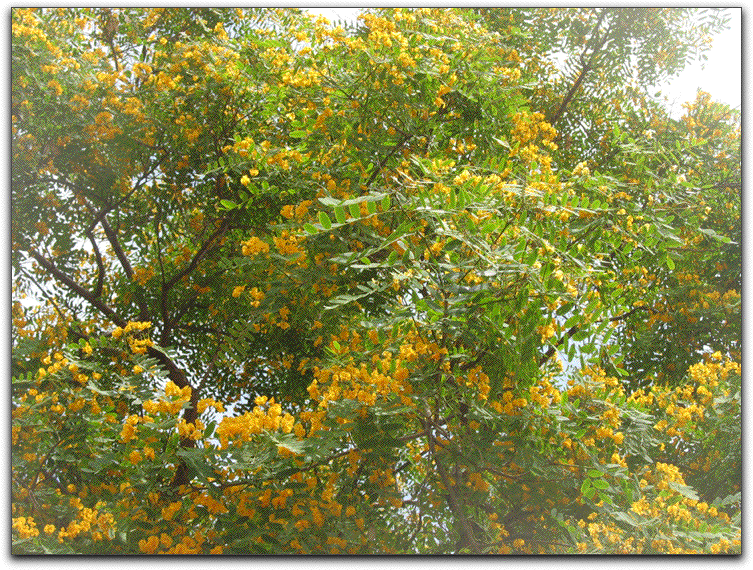
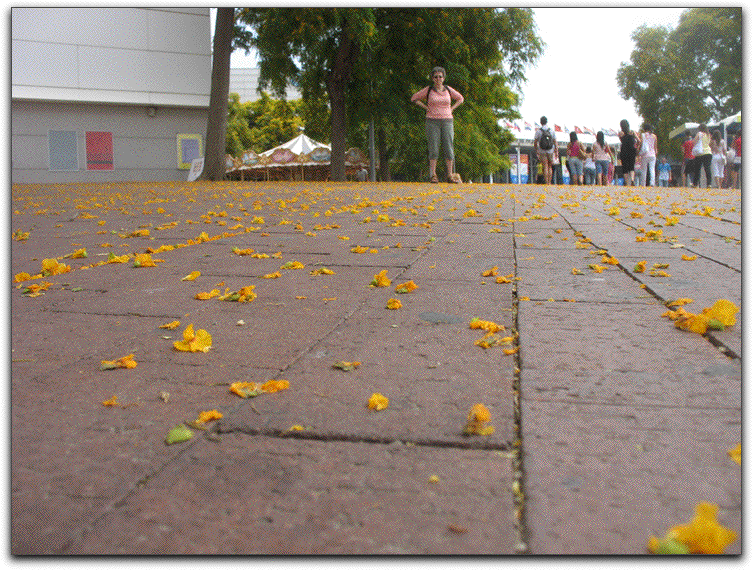
The next day we learned that it is called lausel. We have continued to see it throughout our travels.

As seems clear from the above photo, Mark uses the camera to take notes. He no longer writes down the names of books, but takes photos of their covers and the bar code with the ISBN.
Prague or Barcelona
Barcelona can vie with Prague as a tourist city. Rambla, the beautiful street running from the Plaza de Catalonia down to the port is so crowded that Debbie and I found alternate routes whenever we were in the area, checking only the unusual birds for sale there. And we were in the area plenty.
Jews and Chocolate
Most of the chocolate purveyors Debbie had on her list were in “the old town” or Gotti (Gothic) which also includes the area of the Judería. So, in that regard we were able to accomplish a lot, not that in this instance there is any association between Jews and chocolate. Any vestiges of pre-Expulsion Jewish life (especially a synagogue) in Barcelona are invented, as a tour guide we encountered told a group in Hebrew as he led them through the Call.

The area is called the Road of the Community… a combination of Spanish and Hebrew: “Carrer del Call” (Carrer (Spanish) = way, row, avenue, etc. & Call = Ka[Ha]L (Hebrew) = Community).
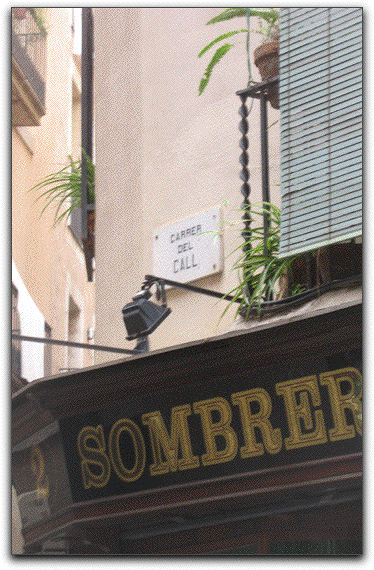
Metal signs all over the area maintained by the community of Barcelona and the network of Jewish areas

give fairly clear explanations of where you are and what was there earlier.
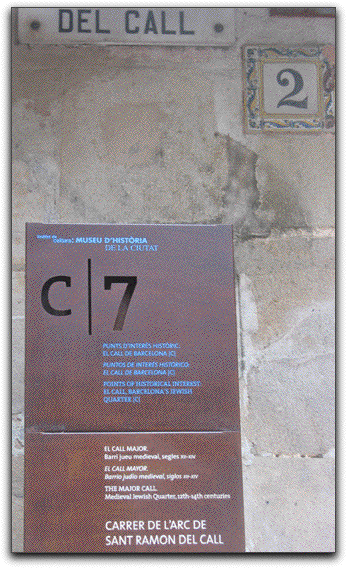
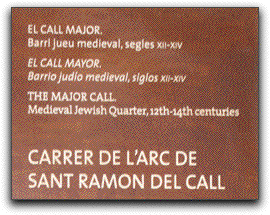


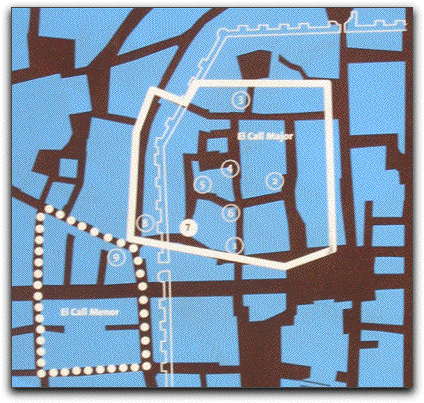
Does the phone booth on Carrer del Call in the following photo give new meaning to the phrase “call girl?” (MH)
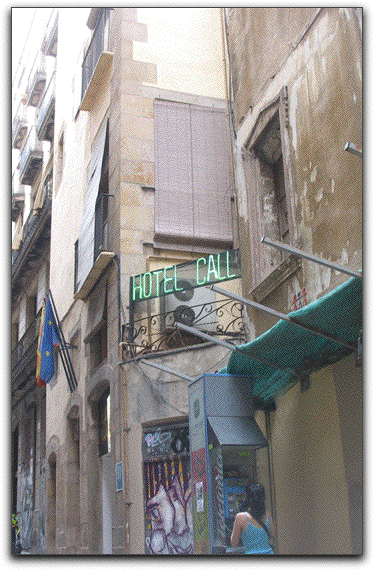
“The former Major Synagogue of Barcelona”
Despite the warning of this Israeli tour guide, who said there are no synagogues, we “found” a “synagogue”.

Are we sure it is (or was) a synagogue? The private group, Asociación Call de Barcelona, that welcomes you to the synagogue (the tiny space functions as one now and then) and maintains the space has produced an impressive little brochure. We’ve not had a chance to check the Web site yet.
The people from the synagogue encouraged us to see a contemporary furniture store that may have housed a mikvah. The proprietor welcomes you in and tells you it was behind those arches… but, who’s to know? We looked, but didn’t see anything more than a floor, certainly nothing that resembled a mikvah.
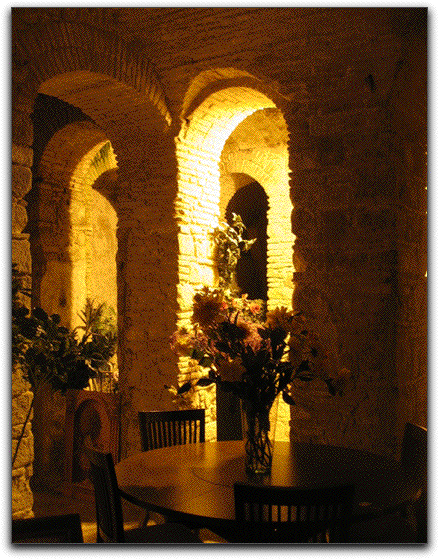
The other Debbie had learned about, Caelum, of all places!, a chocolate shop. Or at least it is a shop where you can get all kinds of sweets and a cup of hot chocolate (which we did).

It also, supposedly had a mikvah (downstairs). [OK, I used flash because, otherwise, you can’t see anything]. I don’t know what makes this room a candidate for a mikvah either. I see no steps into a bath area. We’ve seen our share of medieval mikvaot (in Speyer and Worms):

It seems that some want to be a part of the Jewish tourist business. Desperate to get rid of all the Jews 500 years ago, now, they want us to come visit and they’re “discovering” sites to bring Jews to tour them.
Now you see it, now you don’t
The names of streets in “old town” change often and are frequently not particularly well marked. This posed a special problem with trying to find one particular chocolate shop, “Dulcinea” on “Petritxol”. We received frequent instructions that it was “down this road and around that corner to the right” then “down that road and around another corner to the left”, or “go through the plaza and then up the street that angles off…” only to find that we, indeed, had been on the street up and down it a few times, we even knew from the special signs that the shop was supposed to be there,
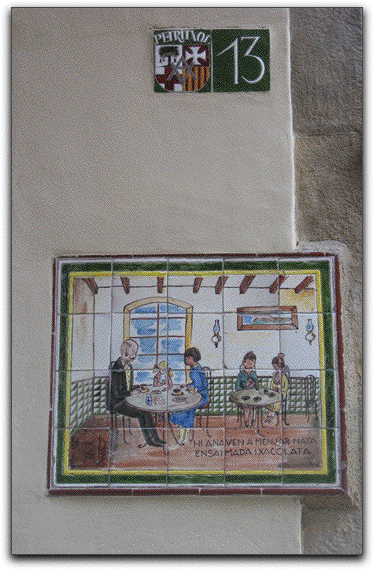
but we had not been able to find it… partly because it was closed for the afternoon and would reopen in the evening.
When we returned, the place was packed. We ordered what we thought was the appropriate chocolate drink treat
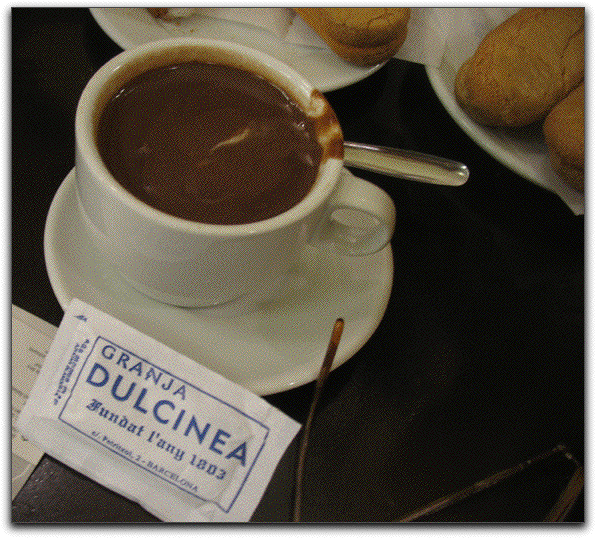
and the owner/proprietor gave us a little history of the family business.
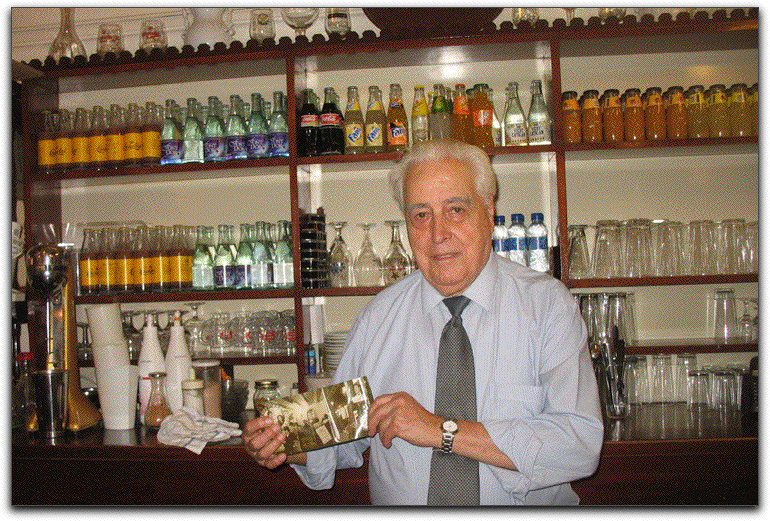
The Joke’s on George
Mark had wanted to ask the people at the tourist offices we visited which was George Orwell’s favorite bar when he was in Barcelona during the Spanish Civil War. But, he doubted he’d find anyone who knew, and didn’t think the bar would still exist. There is, however, a plaza dedicated to Orwell.
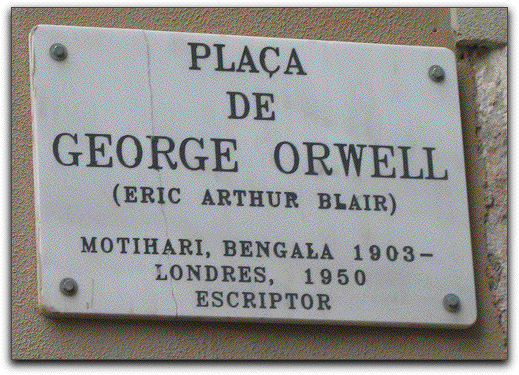
But, ich, yuk, what a place. This seems to be the official pot-heads’ congregating point. The plaza reeks of weed, and the denizens are mostly on the skids.
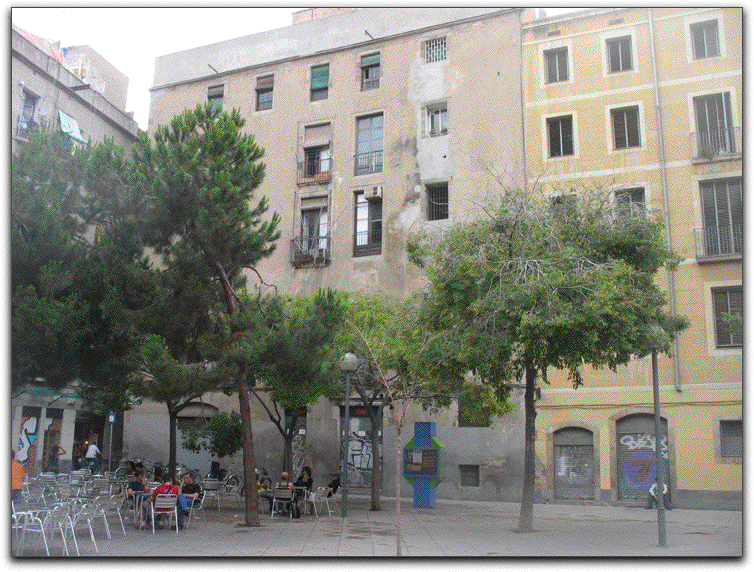
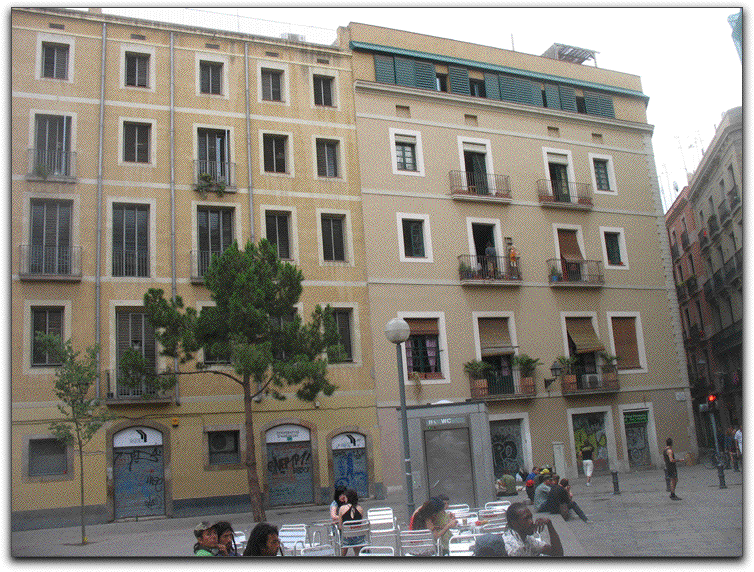

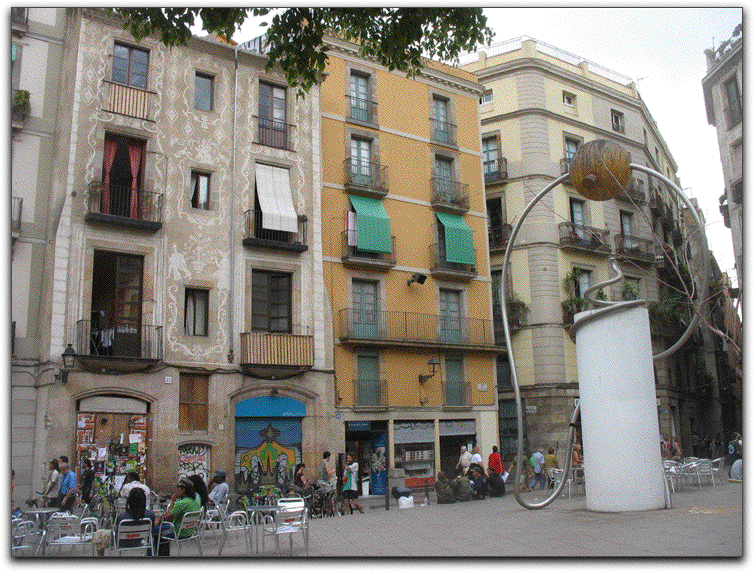
The sculpture is not bad for public art.
One of the odder juxtapositions was a Moslem woman in a burka living next to the sex shop.
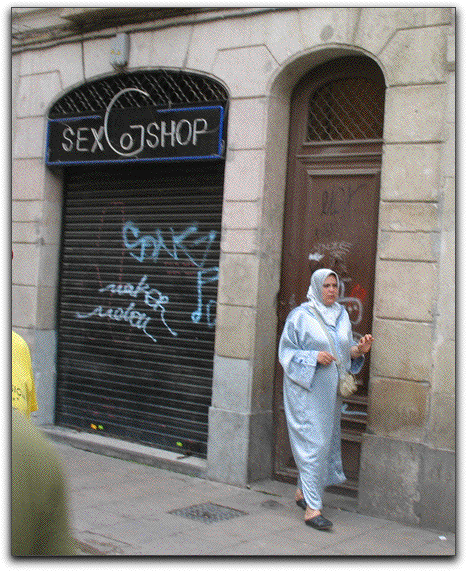
But, the saddest irony is this:

Not that we looked hard to find them, but, while we did see surveillance cameras in a variety of places, we did not see any other signs indicating active surveillance elsewhere in town.
We’re posting this, even though there’s more to Barcelona. Another page of Barcelona stories should appear in a few more days.
start || back || next




































